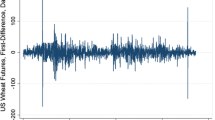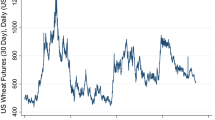Abstract
This paper investigates the presence of herding behavior across a spectrum of commodities (i.e., agricultural, energy, precious metals, and metals) futures prices obtained from Datastream. For the first time in English-language literature, this study provides an explicit investigation of the role of deviations of U.S. monetary policy decisions from a standard Taylor-type monetary rule, in driving herding behavior with respect to commodity futures prices, spanning the period 1990–2017. The results document that the commodity markets are characterized by herding. Such herding behavior is not only driven by U.S. monetary policy decisions. Such decisions exert asymmetric effects on this behavior. An additional novelty is that the results document that herding is stronger during discretionary monetary policy regimes.
Similar content being viewed by others
References
Ahrend, R., Cournede, B., & Price, R. (2008). Monetary policy, market excesses and financial turmoil. Working paper, no. 597, OECD economics department. https://doi.org/10.1787/244200148201.
Barsky, R. B., & Kilian, L. (2004). Oil and the macroeconomy since the 1970s. Journal of Economic Perspectives, 18(1), 115–134.
Batini, N., & Haldane, A. G. (1999). Forward-looking rules for monetary policy. In J. B. Taylor (Ed.), Monetary policy rules. Chicago: University of Chicago Press.
Bernanke, B, S. (2004). Central Bank talk and monetary policy. Remarks at Japan society corporate luncheon, Board of Governors of the Federal Reserve System, https://www.federalreserve.gov/boarddocs/speeches/2003/20030531/.
Bernanke, B. S. (2010). Monetary policy and the housing bubble. Speech given at the American economic association annual meeting. Atlanta: https://EconPapers.repec.org/RePEc:fip:fedgsq:499.
Bernanke, B, S., & Gertler, M. (1999). Monetary policy and asset Price volatility. In: New challenges for monetary policy, Jackson Hole Symposium. Federal Reserve Bank of Kansas City Review, 77–128. https://www.nber.org/papers/w7559.pdf
Bernanke, B., & Kuttner, K. (2005). What explains the stock Market’s reaction to Federal Reserve Policy? Journal of Finance, 60(10), 1221–1257.
Bikhchandani, S., & Sharma, S. (2001). Herd behavior in financial markets. IMF Staff Papers, 47(2), 279–310.
Bikhchandani, S., Hirshleifer, D., & Welch, I. (1992). A theory of fads, fashion, custom, and cultural change as informational cascades. Journal of Political Economy, 100(6), 992–1026.
Bondt, W. F., & Thaler, R. (1985). Does the stock market overreact? Journal of Finance, 40(6), 793–805.
Cai, Z. (2007). Trending time-varying coefficient time series models with serially correlated errors. Journal of Econometrics, 136(1), 163–188.
Campbell, J. Y., & Cochrane, J. H. (1999). By force of habit: A consumption-based explanation of aggregate stock market behavior. Journal of Political Economy, 107(2), 205–251.
Castro, V. (2011). Can central banks’ monetary policy be described by a linear (augmented) Taylor rule or by a nonlinear rule? Journal of Financial Stability, 7(2), 228–246.
Chang, E., Cheng, J., & Khorana, A. (2000). Examination of herding behavior in equity markets: An international perspective. Journal of Banking & Finance, 24, 1651–1679.
Chiang, T. C., & Zheng, D. (2010). An empirical analysis of herding behavior in global stock markets. Journal of Banking & Finance, 34(17), 1911–1921.
Chiang, T. C., Li, J., & Tan, L. (2010). Empirical investigation of herding behavior in Chinese stock markets: Evidence from Quantile regression analysis. Global Finance Journal, 21(1), 111–124.
Christiano, L., Ilut, C., Motto, R., & Rostagno, M. (2007). Monetary policy and stock market boom-bust cycles. Mimeo, https://www.ecb.europa.eu//pub/pdf/scpwps/ecbwp955.pdf.
Clarida, R., Gali, J., & Gertler, M. (2000). Monetary policy rules and macroeconomic stability: Evidence and some theory. Quarterly Journal of Economics, 115(1), 147–180.
Clogg, C. C., Petkova, E., & Haritou, A. (1995). Statistical methods for comparing regression coefficients between models. American Journal of Sociology, 100(10), 1261–1293.
Coenen, G., & Wieland, V. (2005). A small estimated euro area model with rational expectations and nominal rigidities. European Economic Review, 49(10), 1081–1104.
Constantinides, G. M. (1990). Habit formation: A resolution of the equity premium puzzle. Journal of Political Economy, 98(3), 519–543.
De Angelis, D., Hall, P., & Young, G. A. (1993). Analytical and bootstrap approximations to estimator distributions in linear regression. Journal of the American Statistical Association, 88(11), 1310–1316.
Demirer, R., Lee, H. T., & Lien, D. (2015). Does the stock market drive herding behavior in commodity futures markets? International Review of Financial Analysis, 39(1), 32–44.
Devenow, A., & Welch, I. (1996). Rational herding in financial economics. European Economic Review, 40(4), 603–615.
Economou, F., Kostakis, A., & Philippas, N. (2011). Cross-country effects in herding behavior: Evidence from four south European markets. Journal of International Financial Markets, Institutions and Money, 21(3), 443–460.
Economou, F., Hassapis, C., & Philippas, N. (2018). Investors’ fear and herding in the stock market. Applied Economics, 50(33), 3654–3663.
Ferson, W. E., & Harvey, C. R. (1991). The variation of economic risk premiums. Journal of Political Economy, 99(2), 385–415.
Fishe, R., & Smith, A. (2019). Do speculators drive commodity prices away from supply and demand fundamentals? Journal of Commodity Markets, 15(1), 1–16.
Frankel, J. A., & Rose, A. K. (2010). Determinants of agricultural and mineral commodity prices. In R. Fry, C. Jones, & C. Kent (Eds.), Inflation in an Era of Relative Price Shocks. Reserve Bank of Australia.
Galariotis, E. C., Rong, W., & Spyrou, S. I. (2015). Herding on fundamental information: A comparative study. Journal of Banking and Finance, 50(3), 589–598.
Gleason, K. C., Lee, C. I., & Mathur, I. (2003). Herding behavior in European futures markets. Finance Letters, 1(1), 5–8.
Gürkaynak, R. S., Sack, B., & Swanson, E. T. (2005). Do actions speak louder than words? The response of asset prices to monetary policy actions and statements. International Journal of Central Banking, 1(1), 55–93.
Hammoudeha, S., Nguyen, D. K., & Sousa, R. M. (2015). US monetary policy and Sectoral commodity prices. Journal of International Money and Finance, 57(1), 61–85.
Hayo, B., Kutan, A. M., & Neuenkirch, M. (2012). Communication matters: US monetary policy and commodity Price volatility. Economics Letters, 117(2), 247–249.
Hirshleifer, D. (1988). Residual risk, trading costs, and commodity futures risk Premia. Review of Financial Studies, 1(2), 173–193.
Hwang, S., Rubesam, A., & Salmon, M., (2018). Overconfidence, Sentiment and Beta Herding: A Behavioral Explanation of the Low-Beta Anomaly. Available at SSRN: https://doi.org/10.2139/ssrn.3224321.
Issing, O. (2005). Communication, transparency, accountability: Monetary policy in the twenty first century. Federal Reserve Bank of St. Louis Review, 87(1), 65–83.
Kahn, G, A. (2012). The Taylor rule and the practice of central banking. In Koenig, E.F., Leeson, R., & Kahn, G.A. (Eds.). The Taylor rule and the transformation of monetary policy, California, Hoover Institution Press, Stanford University.
Kilian, L. (2008). The economic effects of energy Price shocks. Journal of Economic Literature, 46(6), 871–909.
Kuttner, K., & Bernanke, B. (2005). What explains the stock Market’s reaction to Federal Reserve Policy? Journal of Finance, 60(10), 1221–1258.
Narayan, P. C., Sharma, S. S., & Thuraisamy, K. (2015). Time-varying herding behavior, global financial crisis, and the Chinese stock market. Review of Pacific Basin Financial Markets and Policies, 18(2), 155–169.
Nikolsko-Rzhevskyy, A., Papell, D., & Prodan, R. (2014). Deviations from rules-based policy and their effects. Journal of Economic Dynamics and Control, 49(1), 4–17.
Raimundo Júnior, G., Palazzi, R. B., Klotzle, M. C., & Pinto, A. C. F. (2020). Analyzing herding behavior in commodities markets: An empirical approach. Finance Research Letters, 35(1), 1–5.
Reeve, T, A., & Vigfusson, R, J. (2011). Evaluating the forecasting performance of commodity futures prices. International finance discussion paper, no. 1025, Board of Governors of the Federal Reserve System, http://www.federalreserve.gov/pubs/ifdp/2011/1025/ifdp1025.pdf.
Thomson Reuters (2018). Data Stream database, http://datastream.thomsonreuters.com/DswsClient/Docs/Default.aspx
Rigobon, R., & Sack, B. (2003). Measuring the reaction of monetary policy to the stock market. Quarterly Journal of Economics, 118(4), 639–670.
Rigobon, R., & Sack, B. (2004). The impact of monetary policy on asset prices. Journal of Monetary Economics, 51(13), 1553–1575.
Roodman, D. (2011). Estimating fully observed recursive mixed-process models with Cmp. Stata Journal, 11(2), 159–206.
Rosa, C. (2013). The financial market effect of FOMC minutes. Federal Reserve Bank of New York Policy Review, December, 67–81. Available at: https://www.newyorkfed.org/medialibrary/media/research/epr/2013/0913rosa.pdf.
Rudebusch, G. D., & Svensson, L. E. O. (1999). Policy rules for inflation targeting. In J. B. Taylor (Ed.), Monetary Policy Rules. Chicago: University of Chicago Press.
Smales, L. A., & Apergis, N. (2016). The influence of FOMC member characteristics on the monetary policy decision-making process. Journal of Banking & Finance, 64(2), 216–231.
Sockin, M., & Xiong, W. (2012). Feedback effects of commodity futures prices. Working Paper, Princeton University, https://epge.fgv.br/sites/default/files/feedback-effects-of-commodity-futures-prices.pdf.
Taylor, J. (1993). Discretion versus policy rules in practice. Carnegie Rochester Conference Series on Public Policy, 39(2), 195–214.
Taylor, J. (2007). Housing and monetary policy, In Housing, Housing Finance, and Monetary Policy. Jackson Hole: Proceedings of the Federal Reserve Bank of Kansas City Symposium https://www.kansascityfed.org/publications/research/escp/symposiums/escp-2007.
Taylor, J. (2010). Macroeconomic lessons from the great deviation. In Acemoğlu, D., & Woodford, M. (Eds), NBER Macroeconomics Annual, 25(2), 387–395.
Taylor, J. (2012). Monetary policy rules work and discretion does not: A tale of two eras. The Journal of Money, Credit and Banking, 44(8), 1017–1032.
Williamson, S, D. (2014). Monetary policy in the United States: A brave New World? Federal Reserve Bank of St. Louis Review, 96(1), 111–121.
Wu, J. C., & Xia, F. D. (2016). Measuring the macroeconomic impact of monetary policy at the zero lower bound. Journal of Money, Credit and Banking, 48(2), 253–291.
Zhang, X., & Pan, F. (2019). The dependence of China’s monetary policy rules on interest rate regimes: Empirical analysis based on a Pseudo output gap. Sustainability, 11(1), 25–57.
Acknowledgements
The authors need to express their gratitude to two Reviewers of this journal whose professional and valuable comments and suggestions enhanced the merit of this work. Special thanks also go to the Editor for giving them the chance to revise their work. Needless to say, any remaining errors are within authors’ responsibility zone.
Author information
Authors and Affiliations
Corresponding author
Additional information
Publisher’s Note
Springer Nature remains neutral with regard to jurisdictional claims in published maps and institutional affiliations.
Rights and permissions
About this article
Cite this article
Apergis, N., Christou, C., Hayat, T. et al. U.S. Monetary Policy and Herding: Evidence from Commodity Markets. Atl Econ J 48, 355–374 (2020). https://doi.org/10.1007/s11293-020-09680-4
Published:
Issue Date:
DOI: https://doi.org/10.1007/s11293-020-09680-4




